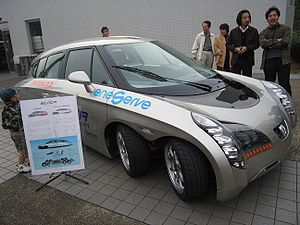
No, this isn’t the gag Funny Car you saw at the county strip. Although it is every bit as fast, making a Porsche 911 Turbo and a Mitsubishi Lancer YouTube fodder.
Eliica stands for Electric Lithium-Ion Car, and you will most likely never see it on the street. This 640 hp monster was developed by a team at the University of Keio in Tokyo, Japan. It boasts a 0-62 time of 4 seconds and is capable of cruising up to 230 mph. This is no small feat for a car that weighs over 5000 pounds, due mainly to the Lithium-Ion batteries that line the undercarriage. This power is needed to activate the 8 electric motors, one for each of the eight wheels. Each motor is 80 hp, hence the 640 hp total output. Only about 200 cars will be made, given the right amount of corporate sponsorship. And each will be sold for $240,000.
However, this car is more of a statement than anything else. What combustion vehicle do you know can seat five people comfortably, out sprint a Porsche, and travel 230 mph almost silently. The Eliica bypasses limits that are set on normal combustion engine vehicles. You cannot put eight engines on a station wagon; the input, exhaust, and cooling system necessary are only the beginning of your troubles. Electric motors are much more flexible, and Lithium-Ion batteries will inevitably improve. We’ve reached the limits of combustion engine capabilities given their century old, antiquated design. Still, automakers claim the technology for electric cars is not here yet. If a team at Keio University can design and build this wonder with a measly $320,000, I think the technology is here; and its in Tokyo.
Below is the first clip of a five part series on the Eliica. They’re very informative, and you can find the rest on YouTube if you can get through all the languages being thrown around.





